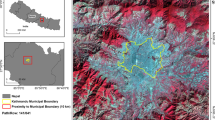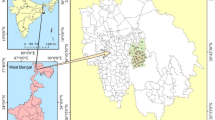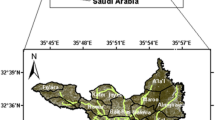Abstract
Analysis of urban sprawl is an issue that has been continuously attracting attention in the planning and research community. Τhis paper presents the results of an analysis of the growth of the city of Rethymno during the 1997–2010 time period. Rethymno is a city in the island of Crete in Greece with population of about 35,000 people, in which developed land has expanded at a rate that is double the growth of the population during the study period. A qualitative analysis was first performed to identify growth patterns in the different parts of the city, how these are related to planning regulations and the extent of cohesiveness of the development. A logistic regression model was estimated using various variables influencing the expansion of the built up area. Variables such as slope, distance from main roads, distance from the University, distance from coastline, as well as variables describing the proximity to other developed areas were used as independent variables in the logistic regressions. Planning constraints with respect zoning were also considered. The accuracy/goodness of fit of the simulation results were also tested using Receiver Operating Characteristic (ROC) curve. The results revealed high (performance) accuracy, which can support the applicability of the proposed method in urban sprawl modeling. Once the equations were estimated they were applied using data from 2010 to identify future trends of urbanization. The methodology adopted in this study can result in a tool that can be of use to urban planning authorities in identifying areas of future urban growth and therefore, adopt zoning policies encouraging or discouraging growth in these areas according to the sustainability objectives of the local community.






Similar content being viewed by others
References
Agarwal, C., Green, G., Grove, J., Evans, T., & Schweik, C. (2002). A review and assessment of land-use change models: Dynamics of space, time, and human choice. UFS Technical Report NE-297. Burlington: U.S. Department of Agriculture Forest Service, Northeastern Forest Research Station.
Chourdakis, A. (2012). Consumption of soil and operational tools limiting urban sprawl. From ZOE to PEPD. Available at: http://www.osddt.eu/en/download/docp/33/Chourdakis_06-12-2012.pdf (Last visited: 14/10/2013).
Domencich, T. A., & McFadden, D. (1975). Urban travel demand: A behavioral analysis. Amsterdam: North-Holland.
Eberts, R. W., & McMillen, D. P. (1999). Agglomeration economies and urban public infrastructure. In: P. Cheshire and E. S. Mills (Eds.), Handbook of regional and urban economics, 3, Chapter 38, (pp. 1455–1495).
Frankhauser, F. (2008). Fractal geometry for measuring and modelling urban patterns. In S. Albeverio, D. Andrey, P. Giordano, & A. Vancheri (Eds.), The dynamics of complex urban systems (pp. 213–243). Heidelberg: Physica-Verlag HD.
Pijanowski, B., Brown, D., Shellito, B., & Manik, G. (2002). Using neural networks and GIS to forecast land use changes: a land transformation model. Computers, Environment and Urban Systems, 26(6), 553–575.
Seto, K., Fragkias, M., Guneralp, B., & Reilly, M. (2011). A meta-analysis of global urban land expansion. PloS ONE, 6(8), e23777.
Tortorella, F. (2005). A ROC-based reject rule for dichotomizers. Pattern Recognition Letters, 26(2), 167–180.
Triantakonstantis, D., & Mountrakis, G. (2012). Urban growth prediction: a review of computational models and human perceptions. Journal of Geographical Information System, 4, 555–587.
Verigos, E. (2013). Land use and sustainable development in some Mediterranean regions. Decentralized Administration of Crete, Creece, Technical Report (In Greek).
Vliet, J., White, R., & Dragicevic, S. (2009). Modeling urban growth using a variable grid cellular automaton. Computers, Environment and Urban Systems, 33(1), 35–43.
Wu, G., Feng, X., Xiao, P., Wang, K., & Zeng, Y. (2009). Simulation and analysis on the land-use patterns of Nanjing City based on AutoLogistic method. 2009 Joint Urban Remote Sensing Event, Shanghai, 20–22 May 2009, 1–6.
Acknowledgments
The research reported in this paper has been funded by the Decentralized Administration of Crete within the framework of the EU project OSDDT (Occupation des sols et development durable du territoire sur l 'arc mediterraneen). The authors would like to acknowledge the assistance of Dr. Nektarios Chrysoulakis and Nikos Manioudakis that during the course of this project discussed various issues.
Author information
Authors and Affiliations
Corresponding author
About this article
Cite this article
Triantakonstantis, D., Prastacos, P. & Tsoukala, A. Analyzing Urban Sprawl in Rethymno, Greece. J Indian Soc Remote Sens 42, 601–610 (2014). https://doi.org/10.1007/s12524-013-0350-8
Received:
Accepted:
Published:
Issue Date:
DOI: https://doi.org/10.1007/s12524-013-0350-8




